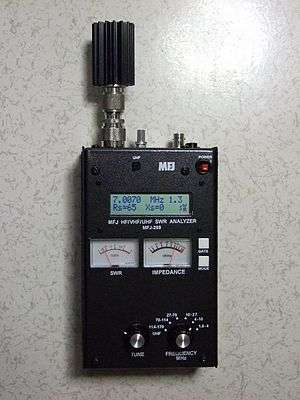Antenna analyzer

An antenna analyzer or in british aerial analyser (also known as a noise bridge, RX bridge, SWR analyzer, or RF analyzer) is a device used for measuring the input impedance of antenna systems in radio electronics applications.
Types of analysers
Antenna bridge
A bridge circuit has two legs which are frequency-dependent complex-valued impedances. One leg is a circuit in the analyzer with calibrated components whose combined impedance can be read on a scale. The other leg is the unknown – either an antenna or a reactive component.
To measure impedance, the bridge is adjusted, so that the two legs have the same impedance. When the two impedances are the same, the bridge is balanced. Using this circuit it is possible to either measure the impedance of the antenna connected between ANT and GND, or it is possible to adjust an antenna, until it has the same impedance as the network on the left side of the diagram below. The bridge can be driven either with white noise or a simple carrier (connected to drive). In the case of white noise the amplitude of the exciting signal can be very low and a radio receiver used as the detector. In the case where a simple carrier is used then depending on the level either a diode detector or a receiver can be used. In both cases a null will indicate when the bridge is balanced.
Complex Voltage and Current meters
A second type of antenna analyzer measures the complex voltage across and current into the antenna. It then uses mathematical methods to calculate complex impedance and display it in either on a calibrated meter or a digital display. Professional instruments of this type are usually called network analyzers. This type of analyzer does not require the operator to adjust any R and X knobs as with the bridge type analyzer. Many of these instruments have the ability to sweep the frequency and thus plot the antenna characteristics over a wide range. Doing this with a manually operated bridge would be time consuming, requiring one to change the frequency and adjust the knobs at each frequency for a null.
High and low power methods
Many transmitters include an SWR meter in the output circuits which works by measuring the reflected wave from the antenna back to the transmitter, which is minimal when the antenna is matched. Reflected power from a badly tuned antenna can present an improper load at the transmitter which can damage it. A complex-impedance antenna analyzer typically requires only a few milliwatts of power be applied to the antenna. This avoids possible damage to the transmitter when the antenna is badly tuned. [1][2] In addition, if the power is very low, the analyzer can be used outside of the frequency bands licensed to the transmitter operator and thus get data on the antenna performance over a range of frequencies.
Uses
In radio communications systems, including amateur radio, an antenna analyzer is a common tool used for troubleshooting antennas and feedlines as well as fine tuning their performance.[3]
Antenna bridges have long been used in the broadcast industry to tune antennas. A bridge is available which measures complex impedance while the transmitter is operating, practically a necessity when tuning multi tower antenna systems.[4] In more recent times the direct reading network analyzers have become more common.
See also
References
- ↑ Practical Radio Frequency Test and Measurement: A Technician's Handbook by Joseph J. Carr, P. 319. Published by Newnes, 1999. ISBN 0-7506-7161-0, ISBN 978-0-7506-7161-3
- ↑ Secrets of RF Circuit Design by Joseph J. Carr, Chapter 17, Building and using the RF noise bridge. ISBN 0-07-137067-6
- ↑ The ARRL Handbook for Radio Communications 2007: The Comprehensive RF Engineering Reference by Mark J. Wilson, Dana G. Reed. Published by American Radio Relay League, ISBN 0-87259-976-0, ISBN 978-0-87259-976-5
- ↑ Battison, John. "Using the operating impedance bridge". Radio, The Radio Technology Leader. New Bay Media. Retrieved 20 July 2016.
Further reading
- Joel R. Hallas, W1ZR (August 2016). "Antenna Analyzers - the basics". QST. American Radio Relay League: 32–34. ISSN 0033-4812.
| Wikimedia Commons has media related to Antenna analyzer. |
